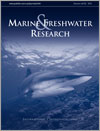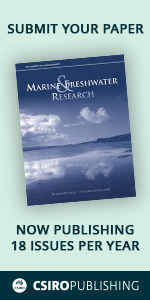Marine and Freshwater Research
Volume 64
Number 10 2013
It remains unclear exactly how tourism affects the behaviour and ecology of feeding predators like sharks. Here, long-term records from a shark-feeding site in the Red Sea reveal increasing sightings and bold behaviour, followed by severe declines that may relate to overfishing. This highlights how the regular provision of food may serve to aggregate predators over time, potentially making them more susceptible to targeted fishing efforts.
Researchers have long speculated as to why Australia, one of the world’s most biodiverse countries, has relatively few species of freshwater fish. Consistent with our hypothesis that this largely reflects the presence of ‘cryptic’ species, we chart species discovery among Australia’s iconic purple-spotted gudgeons, and use genetic data to demonstrate that more remain undescribed. Extrapolation across Australia’s freshwater fishes suggests hundreds of species are yet to be named, let alone assessed for their conservation status.
When estuaries that serve as nursery areas for native fish species are affected by drought, ensuing consequences on fish populations are expected. The present study showed that larval fish assemblages under drought conditions in the Murray Mouth were dominated by small-bodied fish with a noticeable absence of freshwater and large marine species. To function as a nursery for a wide range of species, the estuary needs freshwater flows.
The catchment of the Seteni Estuary, a small intermittently open estuary in South Africa, has been under extensive sugar cultivation for over 60 years. The present study, therefore, aimed to determine the impact of agriculturally derived nutrients on its pelagic communities with the main effects, thus far, being evident in the exceptionally high nitrogen concentrations and imbalance in nutrient ratios. Despite this, the system remains largely functional; although there is potential for deterioration should the catchment become more nutrient-rich through poor management or land-use changes.
This paper provides information about the ecology of hyperbenthic calanoid species in a Mediterranean coastal lake (Lake Faro), previously mainly studied from a taxonomic perspective. Due to the contribution of hyperbenthic calanoid copepods to the copepod assemblage at night, biodiversity increased from daytime to nighttime around the lake. This study confirms the importance of the hyperbenthic calanoid ecological group in increasing functional diversity of this ecosystem.
Validated life history traits (age, growth and reproductive characters) were described for the blacktip reef shark. Growth models and reproductive indicators reveal that the species is relatively slow growing with low reproductive output. However, the study also revealed issues with chemical marking techniques that could lead to underestimating longevity. The slow growth and low reproduction evident suggest that the blacktip reef shark may be sensitive to impacts.
Growth and survival of penaeid larvae depends largely on a number of key factors including temperature. This study uses a variety of size measures to show that 20°C is the optimum temperature for rearing larvae to a large size, while larvae reared at temperature extremes are smallest. The spawning time that would most likely maximise larval size in the Spencer Gulf coincides with current management arrangements for the fishery that protect the spawning biomass at this time of year.
Caulerpa taxifolia is an invasive alga in the Mediterranean Sea being a potential problem for native Caulerpa prolifera. Comparison of both Caulerpa species oxidative status through biomarker measures showed a more oxidised status of the invasive species, probably related to its regression in Mallorca coastal waters. Biomarkers are a useful tool to monitor the adaptation capability of invasive algae to new ambient conditions.
Stocking of predatory fish can have significant ecological consequences for recipient waterways. Most immediate post-stocking movements of juvenile Lates calcarifer were limited and, at the stocking densities used, there was little evidence of predatory impacts on either conspecifics or other species of conservation concern. Translocation of Lates calcarifer into new areas outside their natural range should be very cautiously evaluated.




